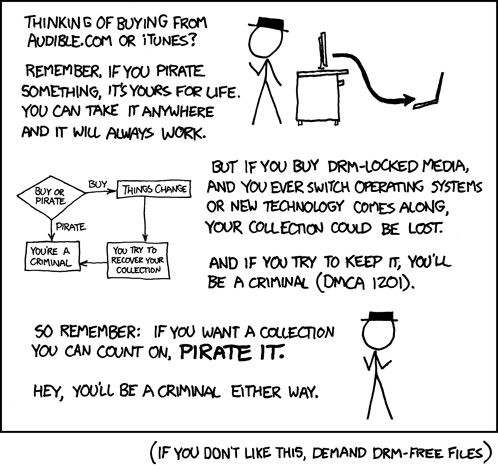Interesting study. Basically, there appears to be a correlation between the amount of DRM on an item and its popularity on BitTorrent. I guess it's too much to hope that the morons responsible for DRM on games take notice.
BitTorrent census: about 99% of files copyright infringing

It has never been a secret that the majority of files being shared over BitTorrent are movies and music that are likely being shared illegally. (Sorry, Linux distro nerds.) Princeton senior Sauhard Sahi confirmed this recently after setting out to survey the content available on BitTorrent and, although there are caveats to his findings, they highlight the relationship DRM has with illegal file sharing. As in: the more DRM there is on the legit versions of the content, the more popular it is on P2P.
Sahi chose a random sample of 1,021 files from the trackerless Mainline DHT and classified them by file type, language, and apparent copyright status. He found that nearly half (46 percent) of files were nonpornographic movies and TV shows—the largest single category of content. 14 percent of the files were porn, tied with the 14 percent dedicated to games and software. Just 10 percent of the files were classified as music, and one percent were books and guides.
Sahi also analyzed whether the content was infringement, checking to see if was in the public domain, freely available via legitimate channels, or user-generated content. Based on this study, 100 percent of the movie/TV show sample was found to be infringing, as well as all of the music torrents. Seven of the 148 files in games/software were found to be noninfringing (two were Linux distros), and one of the 145 porn files was given the benefit of the doubt as noninfringing. Overall, about one percent of the total files were categorized as "likely noninfringing."
So, people largely use P2P to pirate stuff—big surprise. It's the types of files and in what ratios that show us why people share media illegally, however. Music was once the only reason to use P2P networks, and the record industry long feared that going DRM-free would only aid in a massive explosion of illegal file sharing. That has obviously not been the case—P2P users can now share their DRM-free MP3s easier than ever, and yet this category is one of the smallest of all files shared. And it makes sense: why would you bother going to BitTorrent, which may have misnamed and poorly encoded MP3s, when you could easily spend less than a dollar, getting exactly what you want from a place that you trust?
Movies and TV shows, on the other hand, are hugely popular on Bit Torrent—a trend that seems to mysteriously coincide with the heavy DRM and restrictions that come with that kind of content. DVD encryption, browser restrictions, DRM on downloads from iTunes or Amazon—there's effectively no way for consumers to buy this content without restrictions, so they're turning to P2P to get it.
XKCD says it best:
Of course, Sahi's results are only from Mainline and may not reflect the entire P2P system as a whole. His data also includes all files being shared, some of which may not be getting any downloads, while others are being downloaded en masse. Still, it's reasonable to assume that most users share what's in demand, and what's in demand right now is heavily-DRMed movies, movies, TV, and movies

















